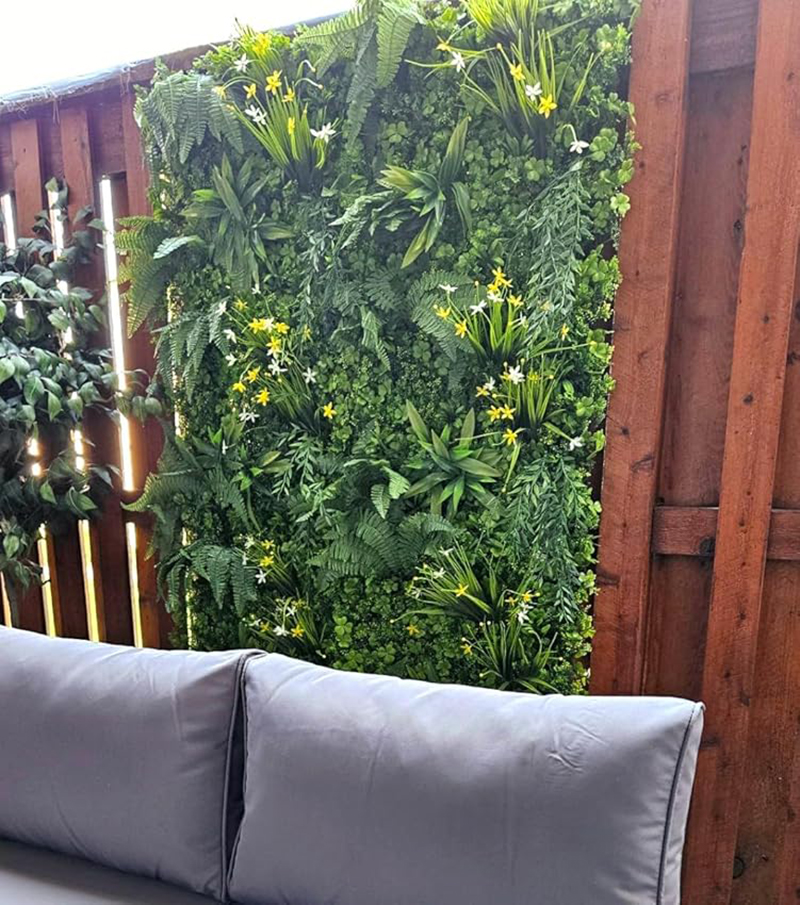The wall fixation methods for 3D artificial vertical gardens need to take into account structural stability, plant growth requirements, and construction convenience. The following are common fixation methods and precautions:
The load-bearing walls are directly fixed
If the load-bearing capacity of the wall is sufficient, the independent steel structure can be omitted and the fasteners (such as expansion screws, dovetail screws) can be directly installed on the wall.
Reserve 20 centimeters of space at the top for plant growth and 20 centimeters at the bottom for drainage and cleaning.
Independent steel structure construction
The steel structure frame is fabricated according to the design drawings and fixed to the wall by welding or bolt connection.
The frame needs to take into account the plant load, wind pressure and the weight of the irrigation system to ensure stability.
Module snap-on installation
Use a nail gun or expansion screws to fix modular components (such as planting boxes, geometric monomers) to the wall or steel structure.
Components can be flexibly spliced together to form different patterns and landscape effects.
Building-block assembly
The modular planting box is adopted and combined by snap-on or splicing methods, which can be installed by one person.
The planting box should have the functions of water storage and drainage to ensure the health of the plant roots.
Tiling fixation
Plant growth substrates or modules are directly laid on the wall to form a planting plane system.
The substrate should have waterproof and root-blocking functions, and the total thickness should be controlled at 10 to 15 centimeters.
The construction cost is reduced through irrigation with tap water and rainwater.
Cloth bag type fixation
Lay soft plant growth carriers (such as felt, coconut fiber) on the waterproof treated wall surface and sew cloth bags filled with substrates and plants.
The cloth bags are fixed to the wall with nails or glue and are suitable for irregular or curved structures.
The climbing support is fixed
Set up planting pools at the bottom of the wall and install climbing supports (such as grids and ropes) to guide the growth of climbing plants (such as ivy and ivy).
The supports need to be inspected and maintained regularly to ensure uniform plant coverage.
The hanging device is fixed
Use hanging flowerpots or planting troughs and fix them to the steel structure or wall with hooks or ropes.
Hanging plants (such as pothos and spider plants) should be shade-tolerant varieties and avoid direct strong light.
V-shaped plate groove installation
Install V-shaped board grooves at certain intervals on the wall surface, fill them with lightweight planting substrates and then plant the plants.
The board grooves should have drainage functions to prevent water accumulation from causing plant root rot.
Fix the horizontal planting trough
Embed planting boards along the horizontal direction of the wall to form planting grooves, and plant shrubs, flowers, or climbing plants with strong climbing ability.
The planting troughs need to be regularly cleaned and replanted to maintain the landscape effect.
Waterproof treatment
Before fixing the wall, waterproof treatment should be carried out to prevent water from seeping in and causing damage to the wall.
The tiled and bag-type systems need to have waterproof and root-blocking functions.
Load calculation
The fixation method should take into account the total load of plants, substrates, irrigation systems and steel structures to ensure the safety of wall load-bearing.
Maintenance convenience
The fixation method should be convenient for later plant replacement, irrigation system maintenance and pest control.
Ecological coordination
The fixation method should be in line with the growth habits of the plants to avoid restricted growth or death of the plants due to improper fixation.
Through the above fixation methods, the 3D artificial vertical garden can achieve a stable, beautiful and eco-friendly wall greening effect. When designing, it is necessary to flexibly select the fixation scheme in combination with the site conditions, plant characteristics and usage requirements to ensure the long-term stable operation of the system.

Contact: Amy
Phone: 86-15311787313
E-mail: info@foszmac.com
Whatsapp:86-15311787313
Add: Fengtai District, Dacheng Road, No.24 Building, Room 203, Beijing, China